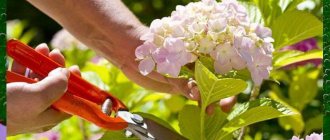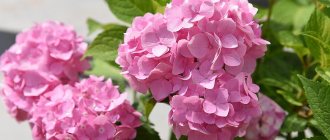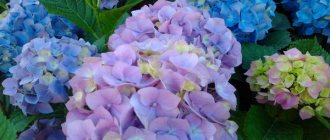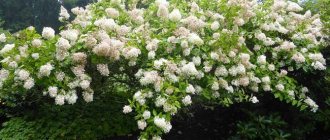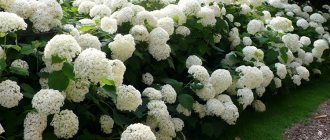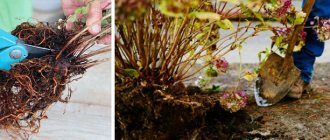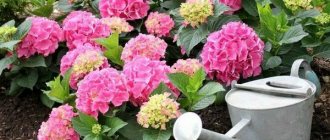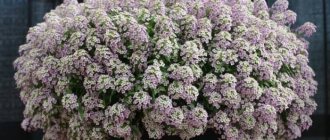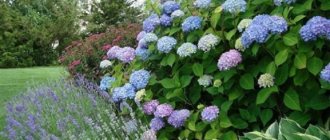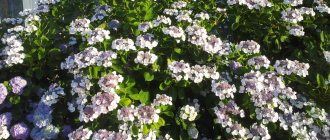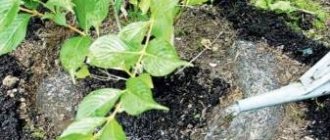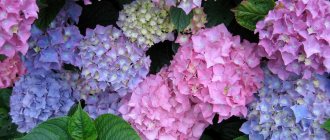Description of the variety
Hydrangea paniculata Bobo or paniculata hydrangea Bobo is a dwarf shrub that grows no more than 70 cm in height. However, its diameter is only half a meter. The shoots and fairly small leaves of Bobo, in contrast to the large-leaf varieties, are dark green, so against their background the large panicle inflorescences look very impressive.
Did you know? Hortense is named after the princess of the Roman Empire, who had the name Hortense.
These inflorescences consist of many small flowers, somewhat reminiscent of phlox. The color of the flowers depends on the mineral content of the soil. Their natural color is snow-white, but if iron or aluminum compounds are added to the soil, the flowers acquire yellowish, soft lemon or light pink shades. This variety begins to bloom in June, but only in small single inflorescences.
And from July to September the bush is covered with a delicate blooming cloud. Hydrangea paniculata Bobo is also so popular due to its excellent resistance not only to winter frosts, but also to frosts that often occur in spring. And it is also absolutely unpretentious in the choice of soil, so it is not difficult to grow it in any garden plot.
Where to buy and cost of the plant
You can buy Bobo hydrangea in flower shops, and if such seedlings are not available, you can negotiate with the seller for an additional supply.
You can also purchase young bushes in online gardening stores, especially since here you can enjoy the opportunity to see the future plant in the photo and read the description of its care. The cost of hydrangea seeds is from 30 rubles. The price of a young bush varies from 700 to 1500 rubles, depending on its height and diameter.
In landscape design
Due to its excellent external characteristics, Bobo paniculata hydrangea is widely used in landscape design. It looks very impressive in group plantings along borders; it is used to zone the territory of a garden and park. It can decorate both garden plots and urban recreation areas for children and adults. It is planted for landscaping loggias and gazebos.
The panicle inflorescences look very beautiful together with the spherical ones, but they need to be planted in a certain order, which will favorably emphasize the beauty of each bush. You can also plant multi-colored paniculate hydrangeas together or combine Bobo with pink and lilac phloxes.
Gardening tips
- Experienced gardeners note that the color of hydrangea depends on the presence of aluminum sulfate in the soil. There are drugs on sale that help it change color.
- In autumn, it is better to replant plants with a strong root system. This will allow the hydrangea to take root and become stronger before frost begins. Weak plants take longer to accept and may not survive the cold winter.
- As soon as the hydrangea inflorescences weaken and decrease in size, it needs a rejuvenating haircut. The bush is pruned “under the stump”, that is, stems 15-20 cm long from the ground are left. The plant tolerates such manipulation well. It grows very quickly and blooms luxuriantly again.
Popular articles How to prepare a pond for the winter: how to cover it and how to insulate it
It’s not for nothing that hydrangea is called the queen of the garden. This beauty went to this title thanks to its lush and long-lasting flowering. The Bobo variety is winter-hardy and practically not susceptible to disease. Today this plant is winning the hearts of gardeners with its beauty and unpretentiousness.
During flowering, the bush looks like white lace; due to the large number of inflorescences, the leaves are almost invisible. Those who decided to have a Bobo hydrangea in their garden, a description and photo of which we presented in this review, will be pleased with its abundant and long-lasting flowering.
Landing
If you want to plant this unusually beautiful variety of hydrangea at home or in your garden, you need to know the basic rules for planting it. Often it is carried out with seedlings purchased in specialized stores or nurseries. But you can also grow a full-fledged shrub from seeds. This method is otherwise called generative; it is used, as a rule, to conduct breeding experiments.
Seeds
Very often, Bobo hydrangea is grown using seeds. It is advisable to buy them in trusted stores in order to get high-quality seedlings. Sowing is carried out only in autumn, and the air temperature in the germination room should be at +14...+20°C. If the thermometer is higher or lower than this level, the process may be disrupted.
Care
Hydrangea Bobo is so loved by gardeners precisely because of its ease of care. In order for this plant to grow well and bloom long and abundantly, it is necessary to feed it in time, water it, loosen the soil, form a crown and prepare the bushes for wintering.
Watering and fertilizing
Watering should be carried out at least twice a week in the summer so that the soil does not dry out, as this can lead to the plant dying. In cloudy weather and during rains, you can water once instead of twice. The water should be settled or rainwater, since the lime contained in tap water is very harmful to hydrangea.
Important! It is recommended to add a few grains of potassium permanganate to the water for watering paniculata hydrangea.
Feeding this variety is necessary to ensure better growth and flowering. The main thing is to fertilize on time and in the required quantities. In spring, summer and autumn, the volume and quality of fertilizing may vary. It is necessary to ensure maximum nutrition of the plant with useful substances.
Feeding Bobo hydrangea is carried out according to the following scheme:
- Immediately after the snow melts, it is necessary to add organic fertilizers to the soil under the bushes so that leaves form better. In this case, mullein solution is perfect.
- During the formation of buds, the plant is watered with a solution of phosphorus and potassium fertilizers, to which urea is added.
- In summer, when the most active phase of flowering is underway, a complex of minerals designed specifically for flowering plants is added. You can buy it in the store ready-made and add it according to the instructions on the package.
- In mid-autumn, it is once again necessary to apply complex mineral fertilizers, which should not contain nitrogen-containing substances. This feeding is carried out to more effectively prepare the plant for winter.
Mulching
The soil under the Bobo hydrangea is mulched to retain moisture, because this is vital for the plant. In addition, this way the soil remains looser and allows air to pass through well, which is very important for feeding the roots. Before mulching, shallow loosening is required , sparing the roots, which are very close to the surface. Tree bark or pine needles are usually used as mulch. You can also sprinkle the ground under the bushes with peat, which will help maintain an optimal acidity level.
Did you know? In North America, archaeologists have found evidence of the existence of hydrangea 40 thousand years ago.
Trimming
Bobo hydrangea bushes are pruned in spring and autumn. It is divided into three types: rejuvenating, sanitary and formative. In early spring, after the snow melts, it is necessary to remove all frozen and damaged shoots. In this case, it is advisable to shorten annuals, leaving no more than 5 buds on each.
In the fall, in preparation for winter, all low-quality branches are cut off again so that they do not interfere with the development of the plant. It would also be a good idea to slightly rejuvenate it by removing all overgrown shoots, as well as those that thicken the bushes.
To decorate the landscape, you need plants with a beautiful, properly trimmed crown, so it can be shaped according to your preferences. The Bobo variety lends itself very well to formative pruning. It is not advisable to skip it, because this can lead to severe thickening, stretching of shoots in height, and also a decrease in the quality of flowering.
Winter hardiness and shelter for the winter
To properly prepare Bobo paniculata hydrangea for winter, you must perform the following steps:
- Reduce the number of waterings starting in September.
- When cold weather sets in, trim off the top leaves.
- When the first frosts begin, trim off the remaining leaves, leaving only the top ones near the new buds.
- Mulch the bushes with peat or leaves. The mulch layer should be at least 10 cm.
In regions with fairly cold winters, it is advisable to press the bushes to the ground and cover them with spruce branches, and if the winter is relatively warm and snowy, you can even do without hilling, because Bobo hydrangea has good winter hardiness and resistance to slight spring frosts.
Pest and disease control
Hydrangea Bobo (photos and descriptions of plant diseases will allow gardeners to recognize them in time and begin treatment) is quite often exposed to various diseases and parasites. This is due to the fact that the bushes grow close to other garden plants, which can become carriers.
It should be noted that the resistance of this hydrangea variety to any problems is great, which makes it possible to promptly detect the disease and get rid of it.
Possible diseases and pests of Bobo hydrangea:
| Problem | Signs | Fighting methods |
| Chlorosis | Yellowing of foliage, brittle branches | Copper sulfate combined with a soap solution copes well with the problem. The resulting mixture is used to treat the foliage and branches of the plant. After the procedure, the bush is watered abundantly. |
| Gray rot | An unpleasant, sticky coating on leaves and branches, which does not come off when trying to remove it. The causative agent of gray rot is a parasitic fungus. | Treating the bush with a solution of Bordeaux mixture will help cope with gray rot. During treatment of the plant, it is recommended to reduce the frequency of watering. |
| Spider mite | A thin, unpleasant cobweb appears on the leaves, which envelops the nearby green mass. Under the influence of the web, the foliage begins to dry out and fall off. | Anti-spider mite spraying solution "Tiofos" is used. |
| Aphid | Small, green pests appear on the branches and inside of the leaves, which quickly envelop the healthy parts of the bush. | The damaged parts of the flower are removed, and the bush itself is sprayed with anabasine sulfate solution. |
| Powdery mildew | Manifests itself in the form of a white coating that affects the plant from the root zone | The cause of powdery mildew is considered to be excessive soil moisture. To eliminate the problem, reduce the number of waterings to a minimum. To quickly get rid of the problem, Bordeaux mixture is used, which is sprayed on all parts of the bush. |
Reproduction
If you want to propagate Bobo hydrangea, you can use three methods: cuttings, dividing the bush and layering. Each of these methods is used at a certain time, and each of them has its own advantages and disadvantages.
Cuttings
Using green cuttings, you can propagate this variety very effectively. They are usually cut in early spring, before buds form.
Important! Insect pests that settle on hydrangeas can be carriers of viral diseases that cannot be treated and lead to the death of the plant.
This process is carried out in the following sequence:
- Choose healthy, strong shoots with at least 5 buds.
- Cut cuttings from them and soak them in a solution of a root formation stimulator.
- Stick them into open ground in a shaded place protected from drafts to the depth of two buds.
- Keep the soil moist to help the cuttings root as quickly as possible.
After rooting, each of them will need to be transferred to a separate container and grown for about two years, and then planted in a permanent place. This method is quite lengthy, and besides, not all cuttings can subsequently become full-fledged plants.
By layering
It is best to propagate by layering in May.
Learn how to replant hydrangeas to another location.
To be most effective, you need to do the following:
- Bend a good young shoot to the ground.
- Make a cut in the part that touches the soil.
- Sprinkle with peat and constantly maintain the required level of humidity.
- After the roots have formed at the site of the cut, carefully separate the cuttings from the large bush and transplant them into a separate container, where they will grow and wait for planting in a permanent place.
Dividing the bush
This method, like cuttings, is also practiced in early spring, when flower buds have not yet appeared.
We advise you to find out why paniculate hydrangea does not bloom.
For this purpose the following events are carried out:
- Dig up a large bush.
- Divide it into several parts so that each of them has buds.
- Shorten the roots a little.
- Dig holes twice as large as the size of the root system of young bushes.
- Fill it halfway with fertile soil consisting of peat, compost and mineral fertilizers.
- Carefully place the bushes in the holes and sprinkle with the rest of the soil mixture.
- Tamp down a little and water the new plant well so that it takes root and begins to grow as quickly as possible.
This method compares favorably with others due to the fact that it is the simplest and fastest. But it can only be used if the bush is too large and can be divided.
What is needed to form a beautiful bush?
Hydrangea Bobo, whose care includes pruning, produces many shoots already in the first year. And if you do not trim the plant regularly, the bushes will not only look neglected, but also the quality of flowering will deteriorate over time.
Hydrangea is pruned in the spring when the buds swell. Leave a few strong stems and cut off the rest. Trim young shoots to 4 buds. This way they will survive the winter better. A few stronger shoots should be left to replace the already faded stems.
When pruning, the main thing is to take time so that the plant has enough time to develop new growth.
